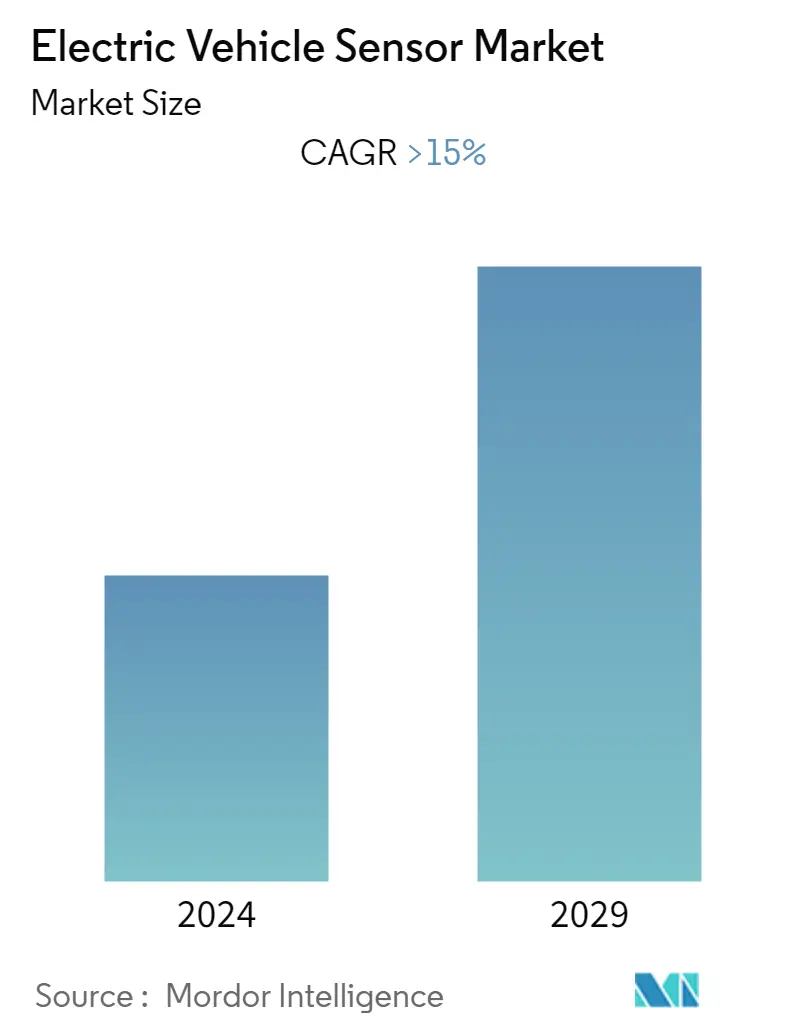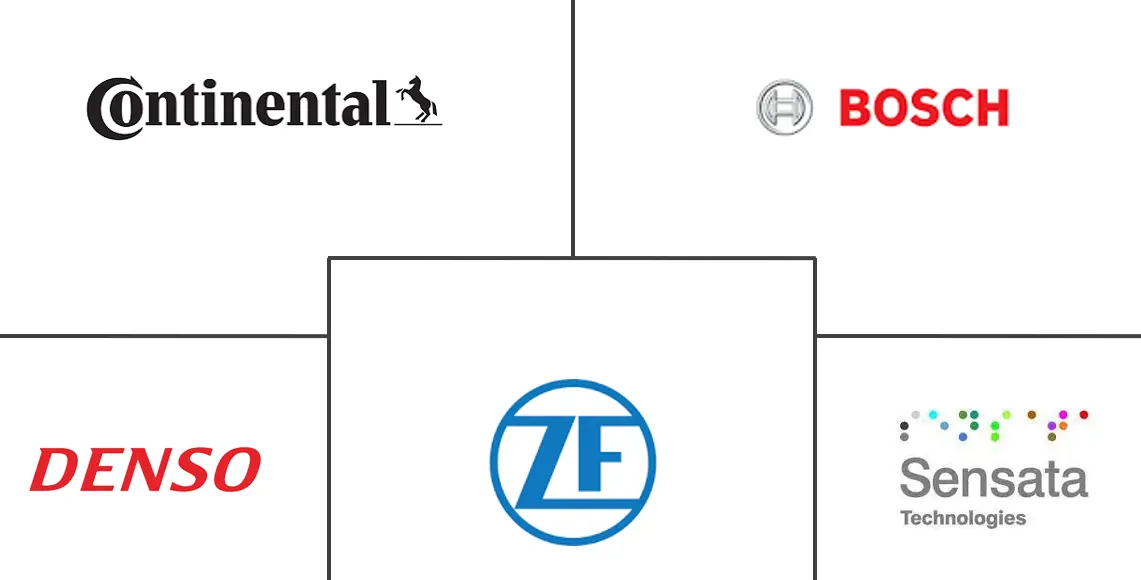Market Size of Electric Vehicle Sensor Industry

| Study Period | 2019 - 2029 |
| Base Year For Estimation | 2023 |
| CAGR | > 15.00 % |
| Fastest Growing Market | North America |
| Largest Market | Asia-Pacific |
| Market Concentration | Medium |
Major Players
*Disclaimer: Major Players sorted in no particular order |
Electric Vehicle Sensor Market Analysis
The electric vehicle sensor market is expected to reach USD 20.09 billion, registering a CAGR of 15% over the next five years.
The COVID-19 pandemic and associated bottlenecks in the supply chain hampered the electric vehicle manufacturing supply chain during the first half of 2020. However, as the lockdown measures were eased, the demand for electric vehicles started picking up pace. In 2020, electric vehicle sales (battery electric vehicles) witnessed an increase of around 33%, which continued in 2021. Such growth in electric vehicle sales is anticipated to drive the demand for a variety of sensors. These sensors include sensors associated with battery management, driver assistance systems, active and passive safety systems, etc.
Over the long term, the growing use of semi-automated and automated vehicles in transportation and logistics will spur the development of electric vehicle sensors. Many prominent players are integrating various sensors such as radar, image, LiDAR, and infrared to improve road safety and autonomous mobility. Growing concerns about the safety of autonomous vehicles have led governments to accept and adopt them across the world. One of the key factors driving market demand is the increasing use of sensors in autonomous vehicles. The increased use of image sensors, temperature sensors, position sensors, and speed sensors in ADAS/AD systems will boost the market growth as the electric vehicle demand is anticipated to be driven by the development of autonomous and semi-autonomous vehicles.
Due to restraining factors like the high cost of electric vehicles, along with a shortage of semiconductors, the market faces challenges.
In the coming years, the European electric vehicle sensor market is anticipated to grow significantly, attributing to the rising demand for cutting-edge technologies, like IoT and AI, in the automotive sector for electric mobility. To ensure passenger safety, systems like ADAS (Advanced Driver Assistance Systems) and EBD (Electronic Brake Force Distribution) are increasingly incorporated into electric vehicles, which further supports product acceptance. Furthermore, the policy environment still drives the uptake of electric vehicles. The 10 leading countries, such as China, the United States, Norway, Germany, the United Kingdom, France, Sweden, and the Netherlands, in electric vehicle adoption have a range of policies to promote the uptake of electric vehicles.
Governments are implementing initiatives and reforms, with heavy investments in the electric vehicles sector, to boost demand and encourage the adoption of electric vehicles in their countries worldwide. In August 2021, the United Kingdom government promised to invest GBP 20 million in projects that help develop zero-emission heavy goods vehicles (HGVs). The Department for Transport (DfT) estimates that the money may help increase the number of zero-emission HGVs on UK roads and improve the infrastructure for such vehicles.
Electric Vehicle Sensor Industry Segmentation
A sensor monitors various aspects of the vehicle and transmits data to the driver or ECU. On the basis of the data gathered by the sensor, the ECU occasionally automatically modifies the specific component.
The electric vehicle sensor market is segmented by sensor type, vehicle type, propulsion type, and geography. By sensor type, the market is segmented into current sensor, temperature sensor, positions sensor, pressure sensor, and other sensor types. By vehicle type, the market is segmented into passenger cars and commercial vehicles. By propulsion type, the market is segmented into battery electric vehicles, plug-in hybrid electric vehicles, and fuel cell electric vehicles. By region, the market is segmented into North America, Europe, Asia-Pacific, South America, and Middle East and Africa. The report offers market size and forecast for the electric vehicle sensor market in value (USD billion) for all the above segments.
| Sensor Type | |
| Current Sensor | |
| Temperature Sensor | |
| Position Sensor | |
| Pressure Sensor | |
| Other Sensor Types |
| Vehicle Type | |
| Passenger Cars | |
| Commercial Vehicle |
| Propulsion Type | |
| Battery Electric Vehicle | |
| Plug-in Hybrid Electric Vehicle | |
| Fuel Cell Electric Vehicle |
| Geography | ||||||||
| ||||||||
| ||||||||
| ||||||||
| ||||||||
|
Electric Vehicle Sensor Market Size Summary
The electric vehicle sensor market is poised for significant growth, driven by the increasing demand for electric vehicles and the integration of advanced sensor technologies. The market is experiencing a resurgence following the disruptions caused by the COVID-19 pandemic, with a notable rise in electric vehicle sales. This uptick is fueling the demand for various sensors, including those used in battery management, driver assistance systems, and safety features. The growing adoption of semi-automated and automated vehicles is further propelling the development of sensors such as radar, image, LiDAR, and infrared, which are essential for enhancing road safety and enabling autonomous mobility. Despite challenges like high vehicle costs and semiconductor shortages, the market is expected to expand, supported by government initiatives and investments aimed at promoting electric vehicle adoption.
Regionally, Europe is anticipated to witness substantial growth in the electric vehicle sensor market, driven by the demand for IoT and AI technologies in the automotive sector. The implementation of systems like ADAS and EBD in electric vehicles is enhancing product acceptance and safety. Government policies in leading countries are also playing a crucial role in boosting market demand. In Asia-Pacific, the market is benefiting from the rising adoption of hybrid electric vehicles and stringent emission regulations. The market landscape is moderately consolidated, with major players like Continental, Robert Bosch, and ZF Friedrichshafen leading innovations in sensor technologies. These developments, along with the increasing focus on autonomous and semi-autonomous vehicles, are expected to create numerous opportunities for growth in the electric vehicle sensor market.
Electric Vehicle Sensor Market Size - Table of Contents
-
1. MARKET DYNAMICS
-
1.1 Market Drivers
-
1.2 Market Restraints
-
1.3 Industry Attractiveness - Porter's Five Forces Analysis
-
1.3.1 Threat of New Entrants
-
1.3.2 Bargaining Power of Buyers/Consumers
-
1.3.3 Bargaining Power of Suppliers
-
1.3.4 Threat of Substitute Products
-
1.3.5 Intensity of Competitive Rivalry
-
-
-
2. MARKET SEGMENTATION (Market Value in Billion)
-
2.1 Sensor Type
-
2.1.1 Current Sensor
-
2.1.2 Temperature Sensor
-
2.1.3 Position Sensor
-
2.1.4 Pressure Sensor
-
2.1.5 Other Sensor Types
-
-
2.2 Vehicle Type
-
2.2.1 Passenger Cars
-
2.2.2 Commercial Vehicle
-
-
2.3 Propulsion Type
-
2.3.1 Battery Electric Vehicle
-
2.3.2 Plug-in Hybrid Electric Vehicle
-
2.3.3 Fuel Cell Electric Vehicle
-
-
2.4 Geography
-
2.4.1 North America
-
2.4.1.1 United States
-
2.4.1.2 Canada
-
2.4.1.3 Rest of North America
-
-
2.4.2 Europe
-
2.4.2.1 Germany
-
2.4.2.2 United Kingdom
-
2.4.2.3 France
-
2.4.2.4 Italy
-
2.4.2.5 Spain
-
2.4.2.6 Rest of Europe
-
-
2.4.3 Asia-Pacific
-
2.4.3.1 China
-
2.4.3.2 Japan
-
2.4.3.3 India
-
2.4.3.4 South Korea
-
2.4.3.5 Rest of Asia-Pacific
-
-
2.4.4 South America
-
2.4.4.1 Brazil
-
2.4.4.2 Argentina
-
2.4.4.3 Rest of South America
-
-
2.4.5 Middle East and Africa
-
2.4.5.1 United Arab Emirates
-
2.4.5.2 Saudi Arabia
-
2.4.5.3 South Africa
-
2.4.5.4 Rest Of Middle East and Africa
-
-
-
Electric Vehicle Sensor Market Size FAQs
What is the current Electric Vehicle Sensor Market size?
The Electric Vehicle Sensor Market is projected to register a CAGR of greater than 15% during the forecast period (2024-2029)
Who are the key players in Electric Vehicle Sensor Market?
Continental AG, Robert Bosch GmbH, ZF Friedrichshafen AG, Denso Corporation and Sensata Technologies, Inc. are the major companies operating in the Electric Vehicle Sensor Market.

